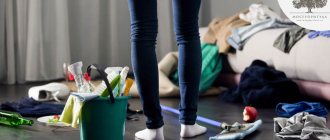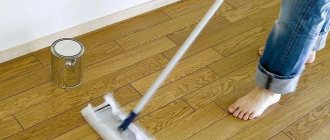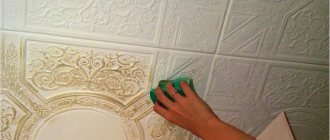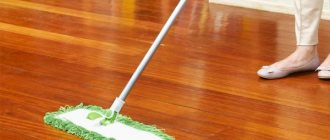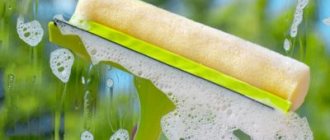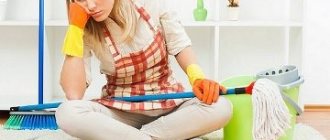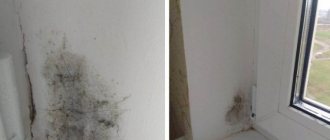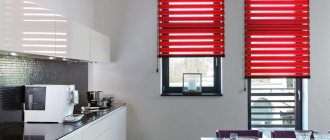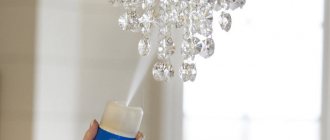Cleaning the house is always a “holiday”. In a figurative sense, of course. This procedure takes a whole day, and after a few days it becomes dirty again. In a word, the work is thankless, but necessary. Well, the dirtiest and most difficult surface to clean is the floor. Therefore, many housewives often face the question of how to wash the floor so that there are no stains on it, so that it sparkles and does not get dirty. The latter is, of course, difficult to accomplish: all people need is to fly. But on the first two points, some recommendations can be given.
General rules
Before you get ready to wash the surfaces you walk on, you need to familiarize yourself with the general rules for this manipulation. These rules apply to all types of floors. Regardless of how you plan to wash the floor, with your hands or with a mop, you must first remove all objects that you can from the surface. This way, the area will be free, and cleaning will become much easier.
It is very important to clean the floors with a broom before wet cleaning. Thin twigs will help pull dust out of far corners and crevices. You just need to work with a slightly wet broom: in a bucket of water, slightly moisten the tips of the rods, then lightly tap on the edge of the bucket to shake off excess droplets.
Now you can start cleaning the floors. This is done from the most distant corner of the room, gradually moving towards the exit. These are general recommendations, and now let’s figure out how to use a mop, which detergents are suitable for which types of surfaces, and how to make surfaces clean without using a mop.
Features of use
For those who do not understand what a mop mop is and doubt the need to purchase one, it is worth citing a number of advantages of such cleaning devices:
- the ability to use attachments for both dry and wet cleaning;
- low price (from 100 rubles *);
- the ability to wash the floor and windows quickly and without streaks;
- MOP can easily be washed in a washing machine and dries quickly;
- Such nozzles do not accumulate chemicals that have a negative impact on human health.
Type of floor and rules for cleaning it
Modern floor coverings can be made of laminate, they can be parquet, they can also be covered with linoleum and tiles, unpainted and painted wood. Each type of floor requires a special cleaning agent and has its own specific treatment.
Laminate flooring can only be washed once a year. The rest of the time, just wipe it with a damp cloth dipped in soapy water.
Parquet flooring is cleaned in the same way as laminate, only after wet wiping it should be rubbed with mastic.
You can completely wash the floor with soap only if it is covered with linoleum. The water should be warm, and cleaning should be done regularly.
Painted wooden floors can also be washed every day. It is especially important to do this in the hallway and kitchen, where they get dirty the most. Such coatings are not afraid of moisture. Stains can be removed with ammonia.
If you have a wooden floor in your home, but not painted, then you are allowed to wash it only once a week. To do this, use hot water and soap. Then you need to rinse the coating well and wipe it with a dry cloth.
The easiest to clean floors are tiled floors. You can even wipe them daily with a damp cloth.
Master Class. Cleaning tile joints.
Step 1. If the dirt on the tile joint is slight, you can use a simple eraser (pink or white). Run an eraser along the seam to remove the stain.
Eraser
Step 2. You can also use baking soda - it can deal with most stains. First, mix baking soda with water to make a paste.
Make a paste of baking soda and water
Apply it to the desired area of the seam using an unnecessary toothbrush. Rub the paste thoroughly into the seam.
The paste is applied with a toothbrush
Remove the paste and rinse off any remaining residue with warm, clean water.
Once everything is dry, rinse the seam with warm water.
If the stain is serious, wait a couple of minutes for the product to penetrate into it, and only then start scrubbing.
Let the paste sit on the stain for a few minutes.
Step 3: For tougher stains, use bleach. But don't forget to use rubber gloves to protect your hands.
Put on a pair of rubber gloves
For white grout, dilute bleach with water (3:1). As for colored seams, you should not use bleach for them, as they may become discolored.
Bleach is diluted in water
Clean the seam with the resulting product; you can use the same toothbrush. Try not to let it get on the tiles.
Cleaning the tile joint
After cleaning the grout, rinse it with warm water to remove any traces of bleach.
Rinse the floor with warm water to remove all traces of bleach.
Once the floor is dry, you can seal the joint with sealant to prevent dirt from being absorbed.
After the floor is completely dry, carefully apply sealant to the seam
Choosing a detergent
It is incredibly important to choose the right floor cleaner. There are a huge number of different floor cleaning products on the market today, but there is a product for each type of flooring. So, for parquet it is necessary to choose a delicate composition that will not damage the floor.
Cleaners that contain alcohol are not suitable for linoleum. Powdered cleaning products are also not recommended. Such concentrates will darken the coating or leave whitish streaks.
Floor tiles should not be cleaned with liquid soap. It is better to rub a little laundry soap into the water or find a detergent containing acid. This product will remove dirt and destroy germs.
For laminate flooring, try to buy a detergent with a neutral pH level. Abrasive substances must not be used to clean floor coverings made of this type of material.
How to wash flooring after renovation
Laundry soap helps to cope with many stains after repair work. The product removes dust, dirt and stains from lime and whitewash. In addition, it can quickly remove fresh traces of water-based paint. The method of application is as follows:
- Wipe the floor with a damp cloth.
- Rub problem areas with laundry soap.
- Leave for 10-20 minutes to act.
- Rinse the floor again.
The following tools will also help:
- vinegar;
- salt;
- vegetable oil;
- dishwashing liquid.
Washing with a mop
How to wash the floors at home, with a mop or with your hands, is up to each housewife to decide for herself. If you need to do everything quickly, then a mop is, of course, better. But if at the same time as cleaning you want to do exercises, then you should work with your hands. But if you decide to use exclusively a mop, then first you should familiarize yourself with the modern types of this tool. In stores you can find the following mops:
- rope;
- butterfly mops;
- with microfiber:
- with sponge;
- steam;
- flat.
Which product to choose is also up to the user. The only important thing here is that the mop is as comfortable as possible for you.
Now let's look at how to properly handle this simple tool. The mop needs to be thoroughly moistened in water and squeezed a little for the first time. Wash the floors, as mentioned above, from the far corner of the room to its exit. From time to time the mop needs to be re-wetted with water. In heavily soiled areas, you need to mop more thoroughly, pressing lightly.
When mopping rough tiles or other textured flooring, use a mop motion as if you were drawing a figure eight. Thanks to this, you will perfectly wash away dirt from the floor.
When everything is done, you need to rinse the mop in clean water, wring it out and set it to dry upside down.
Description of MOP nozzles
It happens that the MOP mop attachment is perceived as a whole cleaning device. But in cleaning companies, a device for cleaning surfaces is called a flounder. This term refers to a device for washing floors, walls and windows, the peculiarity of which is a flat holder on which a replaceable nozzle is placed. It is impossible to say about MOP that it is a complete cleaning equipment. Despite the fact that in English the word “mop” means a mop as a whole, this concept came into Russian as its replaceable part.
Types of MOP nozzles
Flat mops are inexpensive, their handles can be plastic or metal, and most often they are adjustable in length. Depending on the type of flounder, there are several types of MOPs:
- combined nozzles consist of soft long cotton flagella that absorb water and are easily wrung out. They are collected in one bundle, ending with a plastic threaded mount that is screwed to the corresponding thread on the mop. Advantages of rope MOPs: ease of use, the ability to penetrate hard-to-reach places in the room, the ability to wash cracks and seams;
- Tufting is a flat cotton nozzle that is suitable for regular cleaning of medium-dirty areas. Attaching to the base occurs with the help of “ears” and loops at once, thanks to which it stays on it tightly. The main advantages of this type of MOPs are the ability to absorb water well and high wear resistance. This allows cleaning not only in apartments, but also in high-traffic areas;
- loop (loop) MOP is 100% made of microfiber, which makes it rot-resistant and resistant to acids and alkalis. This allows you to disinfect the floor with such a mop. Another advantage is the high level of water absorption.
Interesting! Loop MOS most often comes in gray color, unlike its other bright counterparts.
Washing floors by hand
Many housewives are interested in the answer to the question of how to wash the floor with their hands. Everything is very simple here: choose a suitable rag and cleaning product. Add cleaning liquid to a bucket of water and dip a rag into it. Soak it well and squeeze it out. Now, just as in the case of a mop, you need to wash the coating from the far corner to the middle of the room. Rinse the rag, wring it out and wash the second half of the room. If necessary, wipe the washed surface with a dry cloth.
Linoleum
Linoleum is a durable floor covering if properly cared for.
- Cleaning should be carried out quickly and carefully, avoiding the appearance of scratches and dents on the soft linoleum, which are impossible to get rid of.
- Cleaning chemicals are of an alkaline reaction type.
- Equipment – a mop with a microfiber attachment or a rag made of bamboo fiber.
- Do not use acetone-containing or abrasive products or use them carefully with a mandatory preliminary test on an inconspicuous part of the coating. May cause abrasion or fading of the design.
- Do not wash with hot water, do not rub with soda, do not clean with gasoline or ammonia.
Little trick! Restoring the shine of linoleum is possible by wiping it with a woolen rag soaked in water and milk mixed in a 1:1 ratio.
Which rag is better?
We have already found out which floor detergent to choose. Now we have to figure out which rag is best for washing floor coverings by hand. Previously, old T-shirts and T-shirts were used for this purpose. Today, in stores there are entire departments in which all kinds of rags are presented. Let's look at their most popular types.
Viscose fabric. This material perfectly absorbs and retains moisture. But when it gets wet, it loses its strength. In addition, twisting and hot water are contraindicated for him. Therefore, it is better to purchase not natural viscose, but a rag made of viscose with the addition of synthetic fibers. A viscose rag combined with polyester perfectly absorbs moisture from the floor and wipes it dry. This is an excellent solution for washing surfaces by hand.
A rag containing cellulose has increased absorbent properties.
Synthetics (polyester) cope with dirt better than any natural materials. These rags dry quickly and are durable.
Microfiber is considered a new generation material for cleaning floors. It consists of microscopic fibers of polyester, cotton and others. Such miniature fibers can penetrate into the smallest and most distant crevices and wash away dust and dirt.
Cleaning equipment
In order for the cleaning to be effective, you need to prepare for it in advance. Preparation consists of selecting special equipment - a bucket, liquid soap, protective gloves, a mop, a brush and consumables (for example, rags).
Related links: TV in the bedroom: where to hang it if you really want it
It is recommended to choose rags for washing from natural materials, although synthetics are also suitable. If you need to rub parquet, then use cotton or wool rags for this purpose. You need to take a large bucket - for ease of work, it will be half filled with water.
Folk remedies
Readers will also be interested in learning about how to wash the floor with folk remedies. If there are children in the house, then it is possible that the floor covering can be painted with felt-tip pens. To wipe it off, you need to soak a small rag in gasoline and lightly rub the “image”. Then wipe the area with a damp, clean cloth and wipe it dry. The same method is used to remove traces from sneakers.
To make the flooring shiny, it is recommended to wash it with a solution of milk and water. Liquids must be mixed in one to one proportions. A freshly washed floor can be lubricated with linseed oil, which forms a protective film and thus protects the surface from damage.
Universal methods against stubborn stains
Every housewife has ways to clean the flooring that are suitable for any type of floor. These include:
- When fighting mold, bleach is used. For 6 liters of water, 12 g of chlorine is used. When working with it, you should follow safety rules: after wet cleaning, the room is ventilated. Cleaning is carried out with the windows open, when there are no animals or children in the room.
- To get rid of greasy stains, mix soda and sunflower oil until a creamy slurry forms. The dirt is cleaned with this mixture, then the composition is left for 20 minutes. The remains are removed with a broom, then the coating is washed with cold water.
- Dirt is dealt with using washing powder or dishwashing gel, for example, Fairy.
According to the ancient Slavic tradition, floors should not be washed in the evening; it is better to do this during daylight hours. Thus, a woman brings positive energy, prosperity and prosperity into the house.
Conclusion
Remember: the dirtiest place in any room is the flooring. Sometimes you can wash the floors every day, or even several times a day. No matter how clean you wash the surface, after a day or two dust, pet hair and other debris will still begin to accumulate in the corners. Whatever way you decide to clean your floors, you need to do it with joy, perhaps even love, and then the floor will not just be clean, but sparkling. Your family will appreciate it, and you will be pleased to enjoy the results of your work.
